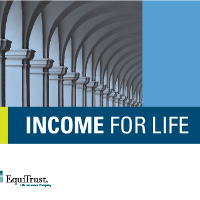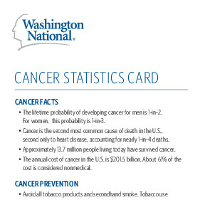Products
Annuities
An annuity is a contract that provides income for a specified period of years, or for life. An annuity protects a person against outliving his or her money. It is not life insurance, but rather a vehicle for the accumulation of money and the liquidation of an estate.
While life insurance protects against premature death by creating an estate, annuities protect against the possibility of outliving one's income by liquidating an estate. An annuity can be defined as a contract between a life insurance company and a purchaser (contract owner) which guarantees a monthly income for the life of the annuitant (a person who receives benefits or payments from the annuity) or for some other specified period of time through a regular series of payments.
Types of Annuities
Immediate Annuities:
This type of annuity provides for a single-sum payment, or premium to be made to the insurance company. In return, the insurance company agrees to make the annuitant a periodic series of payments beginning in 30 days. Because the immediate annuity starts right away it is impossible to put in additional payments on a deferred basis.
Deferred Annuities:
The deferred annuity requires the contribution of single premium, fixed or flexible deposits. You should first determine your financial goals and objectives before making a decision as to which purchase method is better.Deferred Annuity (Accumulation Period):
The amount of contributions that are made during the accumulation period will depend on the choice of deferred annuity chosen by the annuitant. These choices include:
- Single premium
- Fixed payments
- Flexible payments
The dollar amount of the payments will vary depending on the annuitant's financial goals and the insurance company rules.
Single Premium Annuity:
The single premium annuity during the accumulation period requires the payment of one payment only. (e.g. $100,000). These types of annuities will not allow any additional contributions at a later time. If one wishes to add deposits, he or she must purchase a new annuity at the then current interest rates.



Click on the images to view the PDF documents.
Critical Illness/Cancer
Critical Illness Policy:
Pays a lump sum to the insured upon the diagnosis (and survival) of a critical illness. The insured must survive the illness for a certain period of time.
Cancer Policy:
Provides benefits for the actual diagnosis, and/or treatment of cancer and related illnesses caused by cancer or resulting from cancer therapy.
The American Cancer Society reports men have nearly a 1-in-2 lifetime risk of developing cancer, while 1-in-3 women likely will develop cancer at some point in their lives.
After a critical illness diagnosis, unexpected costs can follow:
- Deductibles
- Co-pays
- Coinsurance
- Alternative treatments
- Transportation
- Caregiver costs
And if you experience cancer, heart attack, stroke, diabetic complications, Alzheimer's disease, end-stage renal failure or other common critical illnesses, you can receive both lump-sum and indemnity benefits, depending on the level and type of coverage selected.



Click on the images to view the PDF documents.
Medicare Supplements

This chart shows basic information about the different benefits that Medigap policies cover. If a percentage appears, the Medigap plan covers that percentage of the benefit, and you must pay the rest.
Click on the images to view the PDF documents.
| Medicare Supplement Insurance (Medigap) Plans | ||||||||||
|---|---|---|---|---|---|---|---|---|---|---|
| Benefits | A | B | C | D | F* | G | K | L | M | N |
| Medicare Part A coinsurance and hospital costs (up to an additional 365 days after Medicare benefits are used) | 100% | 100% | 100% | 100% | 100% | 100% | 100% | 100% | 100% | 100% |
| Medicare Part B coinsurance or co-payment | 100% | 100% | 100% | 100% | 100% | 100% | 50% | 75% | 100% | 100%*** |
| Blood (first 3 pints) | 100% | 100% | 100% | 100% | 100% | 100% | 50% | 75% | 100% | 100% |
| Part A hospice care coinsurance or co-payment | 100% | 100% | 100% | 100% | 100% | 100% | 50% | 75% | 100% | 100% |
| Skilled nursing facility care coinsurance | 100% | 100% | 100% | 100% | 50% | 75% | 100% | 100% | ||
| Part A deductible | 100% | 100% | 100% | 100% | 100% | 50% | 75% | 50% | 100% | |
| Part B deductible | 100% | 100% | ||||||||
| Part B excess charges | 100% | 100% | ||||||||
| Foreign travel emergency (up to plan limits) | 80% | 80% | 80% | 80% | 80% | 80% | ||||
| Out-of pocket limit in 2015** | $4,940 | $2,470 | ||||||||
* Plan F is also offered as a high-deductible plan by some insurance companies in some states. If you choose this option, this means you must pay for Medicare-covered costs (coinsurance, co-payments, deductibles) up to the deductible amount of $2,180 in 2015 before your policy pays anything.
** For Plans K and L, after you meet your out-of-pocket yearly limit and your yearly Part B deductible ($147 in 2015), the Medigap plan pays 100% of covered services for the rest of the calendar year.
*** Plan N pays 100% of the Part B coinsurance, except for a co-payment of up to $20 for some office visits and up to a $50 co-payment for emergency room visits that don’t result in an inpatient admission.
Life Insurance
What is Term Life Insurance?
Life insurance is designed to provide your loved ones a cash benefit if you pass away. The money can be used to replace your income, cover living expenses, pay off debts, fund college for your children and much more
Of the various types of life insurance available today, term is the most basic. A term policy can be an affordable, straightforward solution for your life insurance needs. It's easy to understand and even easier to use. The typical consumer chooses a term policy when he or she needs life insurance coverage for a specific period of time, such as 15 years. A few carriers now offer a term policy that can provide coverage throughout a person's working years-up to age 65. If the insured dies during the stated term, the policy pays a lump-sum benefit to his or her beneficiary. Term insurance is a logical solution when the need for coverage ends at some point, such as retirement. It offers the largest coverage amount for the lowest premium. Many consumers choose a term policy as a way to cost-effectively increase their total life insurance coverage. With a term policy, the death benefit remains the same no matter how long it's in force. Premiums are much less than for "permanent" forms of insurance like whole life and universal life. Your insurance carrier also may let you convert your term policy to a permanent policy at the end of the term without requiring additional underwriting or medical exams.
Universal Life Insurance

Universal life insurance lets you build higher cash value tax-deferred. Like whole life, the policy also pays a death benefit tax-free, and the cash value accrues tax-deferred over time.
Universal life insurance differs from whole life in that it offers flexible premium options. You can choose to increase or decrease premium payments to grow your policy's cash value faster or more slowly. The policy remains in force as long as the cash value is not negative.
Another feature of universal life insurance is its flexible death benefit. If you need less life insurance coverage in the future, you can request a coverage amount reduction. If you need more life insurance, you can request a coverage amount increase with evidence that you’re still in good health.
Click on the images to view the PDF documents.
Long-Term Care (LTC)
What is Long-term care Insurance?
Long-term care insurance policies reimburse policyholders a daily amount (up to a pre-selected limit) for services to assist them with activities of daily living such as bathing, dressing, or eating. You can select a range of care options and benefits that allow you to get the services you need, where you need them.
The cost of your long-term care policy is based on:
- How old you are when you buy the polic.
- The maximum amount that a policy will pay per day
- The maximum number of days (years) that a policy will pay
- The maximum amount per day times the number of days determines the lifetime maximum amount that the policy will pay.
- Any optional benefits you choose, such as benefits that increase with inflation
| How Long Do People Need Long-Term Care | |
|---|---|
| 5 years or more | 12.0% |
| 3 to 5 years | 12.0% |
| 1 to 3 years | 30.3% |
| 6 to 12 months | 14.2% |
| 3 to 6 months | 10.0% |
| Less than 3 months | 20.0% |
| Average Length of Stay in Years | ||||||||||
|---|---|---|---|---|---|---|---|---|---|---|
| Female | 2.6 years | |||||||||
| Male | 2.3 years | |||||||||
| Married | 1.6 years | |||||||||
| Single/Never Married | 3.8 years | |||||||||
| Widowed | 2.3 years | |||||||||
| Divorced/Separated | 2.7 years | |||||||||
Nursing Home
Someone in your family will need a nursing home sooner or later. A majority of people over age 65 will require some type of long-term care services during their lifetime. According to the Department of Health and Human Services, about 70% of people over age 65 will require some type of long term care services during their lifetime. However, the need for long term care does not only impact seniors as 40 percent of people currently receiving long term care services are ages 18 to 64.
The average nursing home cost in Illinois is $62,050 for a semi-private room for one year. A private nursing home room cost is $74,643.
Long Term Care Insurance:
This type of private insurance policy can help pay for many types of long-term care, including both skilled and non-skilled care. Long-term care insurance can vary widely. Some policies may cover only nursing home care. Others may include coverage for a whole range of services, like adult day care, assisted living, medical equipment, and informal home care.
Home Health
What is home care?
The majority of people are most comfortable in their own environment where they feel safe and close to the things they love, and home care is the long-term care option that promotes the individual's independence and ability to continue with the normal, daily routine as long as possible. The goal of home care is to provide in-home care for those who need it, and to allow an individual to remain living at home as long as possible, regardless of age or disability.
Home care services cover a wide range of needs, from homemaking and companionship to meal preparation and medication reminders. They may also include personal care services, or those that help with the activities of daily living, including home care services like bathing, dressing, and grooming.
Skilled services that utilize the expertise of a nurse may also be grouped within the home care category. Services include checking vital signs, coordinating with doctors and other healthcare professionals working with the individual, and performing comprehensive evaluations of health and community needs to keep individuals safe at home.
Home care can be great solution for individuals who are not sick enough to need nursing services but just need a little help to stay safe and independent in their homes.
Major Medical
Contact us for more information.
Group Medical
Contact us for more information.